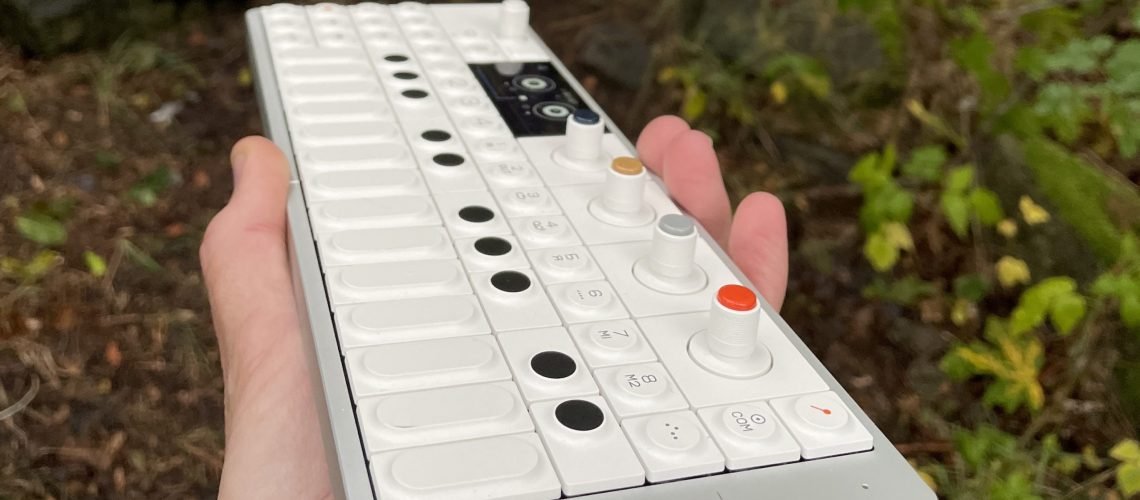Nothing defies trends quite like the Teenage Engineering OP-1. It’s small and lean, but priced alongside pro instruments. It’s a compact luxury synth. We bring back our resident expert on mobile production, Swedish gear, and multifunction compact goodness Andreas Roman to give us a review – or not. Swede anti-reviews Swede. Go. -Ed.
ANDREAS ROMAN
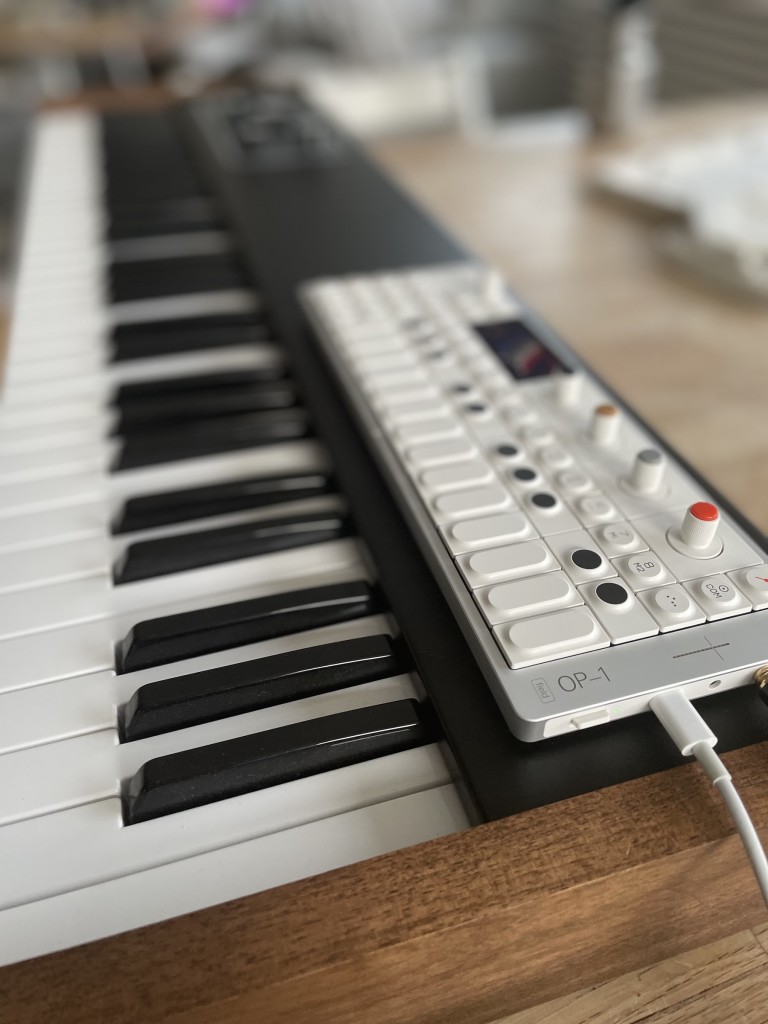
No, it’s not too expensive
Let’s be controversial, like Teenage Engineering. Let’s not review the OP-1 Field. It’s been done to death already by influencers and spin doctors from the YouTube realm. Instead, let’s take this baby to the field, after which it has been so aptly named, and see what it’s made of out there in the wild — beyond desktop cameras and face-plant videos.
Yes, it’s expensive. So is a Prophet 5, an Analog Rytm or a full collection of Korg Volcas. But the build quality, battery power, sound engine, converters, shielding, wireless connectivity, onboard speaker, microphone, and the sampler … I could go on. It all matches up to the asking price. This is premium technology, a distant shout from rubber coating and plastic alloys.
The build quality, battery power, sound engine, converters, shielding, wireless connectivity, onboard speaker, microphone, and the sampler … I could go on.
Whether or not you think it’s worth it, that’s another matter. But if you do, then you know that any kit in this price range sends a message that’s not about the money – it tells you, don’t get into this if you’re not committed. This isn’t a toy or a curiosity. This is you telling yourself, I’m into this.
Four-track commitment
Teenage Engineering describes their field system as something “designed with portability, compatibility and durability in mind”. This idea runs through the OP-1 Field’s entire design ethos, with the digital four-track tape recorder being the point of gravity. You write something. Play it. Record to tape. Mix. Master. Done. The OP-1 Field has the soul of a traveler who made a famed album on a four-track Tascam in a New Jersey bedroom. Considering the legacy of the old-gen version, there’s no point questioning this paradox. For a lot of people, it has worked for over a decade. And it’s substantially improved this time around. Judging from Teenage Engineer’s recent streak of firmware updates, it seems we’re only getting started as well.
I mean, a vocoder, right? Just when you thought you’d heard it all.
If you dismissed the OP-1 before, the Teenagers have made it harder for you now. The lo-fi character of the old-gen version was as convenient an excuse to not engage with it as an attraction for those who liked it. [Ed.: Hey, I still like the lo-fi OG model! Hanging onto mine -PK.] But now, we’re looking at a hi-fi mutation with plenty of headroom for mixdowns and a sound engine that challenges much of what’s out there. Just running stuff into the Field opens sounds up and brings out details in ways that compete with decent analog mixers equipped with strong preamps. The original quirks of the internal synths remain, now exposed to the light of revamped algorithms and smashing converters and with the addition of the classic subtractive Dimension synth.
You can hear it’s still the OP-1. Yet, it’s not really the OP-1. Comparisons on the internet don’t come close to the experience of just playing one. I was so mesmerized by the atmospheres of the Field, on the evening when I unpacked it, I just played it for hours. My Prophet 12 was like, “Really? You fooling around with that little b—h now?” But that’s what you’re looking for if you want a real reference. That’s what I brought into the mud and rain, to shores and studios, into forests and guitar dens, into the field.
A collection of short tracks I’ve made on the Field, and then blended into a brief mixtape. The name felt so appropriate somehow.
It’s a combination of field samples, ambient noodles, live recordings, old synth loops, live jams on the OP’s synths and all kinds of stuff, just a cauldron of juicy stuff really.

Lost in the woods
While I’m a city boy, I’ve set family camp in a spot where we’re close to the river by a forest hill, the beating heart of downtown Gothenburg just a ferry ride away. So I looked to the skies and waited for rain. Fortunately, it’s late Autumn in Sweden so I didn’t have to wait long. Once the grey clouds showed, I went outside and listened for ambience to record.
The original OP-1 had one tape with four tracks. But the Field has four kinds of tapes, ranging from studio quality to worn-down cassette, each with eight slots and four tracks each — more than enough for my birds, waves and winds. With the digital equivalent of a bag full of tape reels with me, I went down to the river, walked along the piers, took a path through the forest and crossed a small mountain, all the while making sure the OP-1 captured everything through its internal microphone. I recorded to studio tape, picked out the best parts, copied and pasted until I had my own little audioscape, used the onboard FX and EQ to trim the frequencies and then dropped it all onto a vintage tape, to get that added flavor.
I would imagine this upgrade alone could be enough for the die hard OP-1 fan to get a Field. It certainly was enough to convince me that whatever experience I’d had with the old OP-1, this resolved many blockers for me in one go. Stereo recording. 32-bit. Superb onboard microphone. Huge amounts of tape memory. Multiple tape slots, all available as sources and destinations to move your music around. I was so into this, I actually got lost in the woods for a while.
The Field has four kinds of tapes, ranging from studio quality to worn-down cassette, each with eight slots and four tracks each –more than enough for my birds, waves and winds.

Chase bliss piano
After I’d found my way home, missing dinner with my wife and kids (“We were about to call the police“), I sat down by my piano, asked the family to turn down whatever was running on Disney+, and switched on some Roland speakers. I played a few takes right into the OP-1’s microphone. I could’ve used the line input for a more precise result, but where’s the fun in that? I wanted some real living room ambience. Since this was a live performance, and I’m no Herbie Hancock, it took me a few tries before I had something I liked. Each failed attempt, I deleted from tape and tried again.
By the time I was done, the family had gone to bed; night had come. I sat down by the kitchen table, used the tape’s loop function to identify a few of my favorite parts and I ran them through my Chase Bliss pedals — MOOD, Habit, blooper and even a little CXM 1978 reverb, just to make sure it didn’t feel left out by the competition from the onboard Mother reverb. I recorded the results back into the Field and threw most of it away, but kept some. Chase Bliss gear is known for many things, but a polite output isn’t one of them, so this took a little more effort. Through the OP-1 Field’s converters, not only did the source translate perfectly but especially the Mood’s textures came alive in a way that made me wonder, maybe I didn’t need much more? Maybe this was my first song on my own Nebraska album.
Made entirely in the OP-1. Synths, samples and whatnot, all from the OP-1. Some resampling through a Chase Bliss Habit, and the whole thing mixed and mastered on a TX-6.
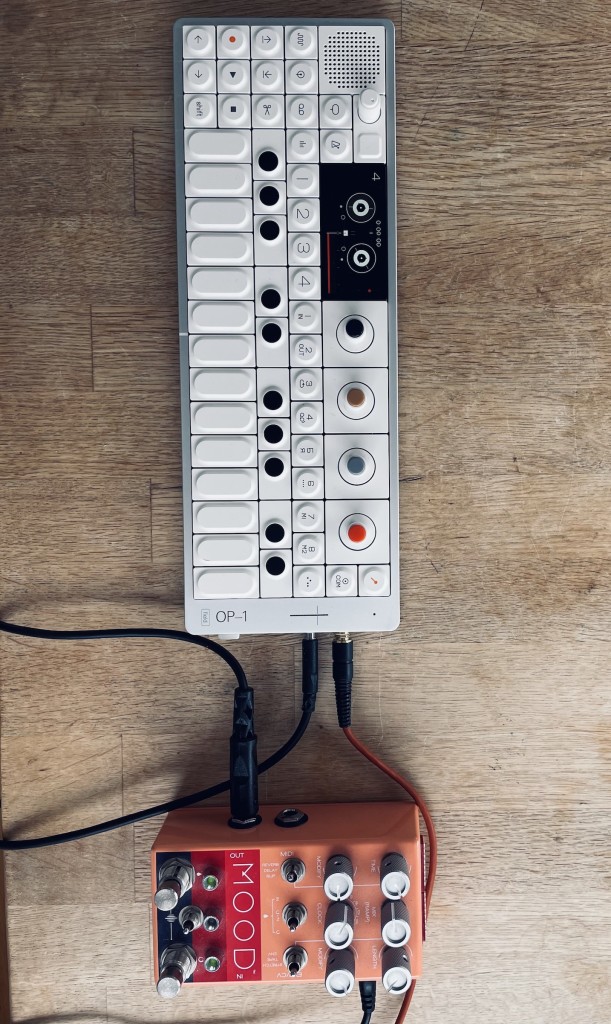
Internal and external
While I repeated these exercises a few times over the days, to just expand on the selection of material, I also got cracking on the internal synths. While they’re somewhat scarce on features – at least if you’re picky with your patch design – they carry a presence that makes up for the lack of complex modulation options, FX chains and triple envelopes. I mean, I love that stuff, too. It’s one of the reasons I remain dedicated to the Prophet 12. But I also love the Prophet 5, which is comparatively simple.
And the OP-1 Field sampler. Dear lord, the sampler. I ran a C3 note from my Prophet 12 into the OP-1, sampled it, and played it. Intellectually, I knew it wasn’t the Prophet I was playing anymore. Emotionally, I was like … really, though? As far as one shot sampling goes to get a polyphonic patch going, this is the best I’ve encountered. Whatever magic the engineers cooked up here, it’s beyond this world.
In comparison, the onboard sequencers are a bit awkward. They can sometimes inspire – especially the more funky ones, the Tombola being my favorite with its raindrop-like qualities on FM bells. But the Field sequencers primarily offer just enough convenience to keep you in the OP-1 environment. The less you’re into the trigger-depths of Elektron, the more you’ll find what you’re looking for right here.
I’m a non-sequencer kind of guy anyway, so I was happily recording improvised synth jams directly onto tape. Since the Field plays well with MIDI, something that took a fair amount of iteration to arrive on the older generation, I always had the option of outboard gear for sequencing. I did try to match the OP-1 with my Circuit Tracks just to see where it would take me, but then you lose something in those more “classic” scenarios. All of the added onboard flexibility means you might want to use it with external gear. But you certainly don’t have to. With the most recent firmware also adding velocity to the internal keyboard, you can even add some level of expression to your click-clack playing without reaching for a controller.
OP-1 Field only. I took it with me to sample slices of conversations, sounds and voices I picked up throughout the day, and then added some pads and atmospheres on that. Ran a few of the tracks through a Chase Bliss Mood, resampled them back into the OP-1 Field and well … there you go.
A little something put together on the Field. This one used the internal synth engines for extensive resampling from tape into sampler, then recorded back onto versions of the tape effects (mostly porta), and dropped as finals on the Studio tape. After that, I added a few more tracks and ran them through a GenLossMKII, a Chase Bliss Habit and a Chase Bliss Blooper and just mixed it all together.
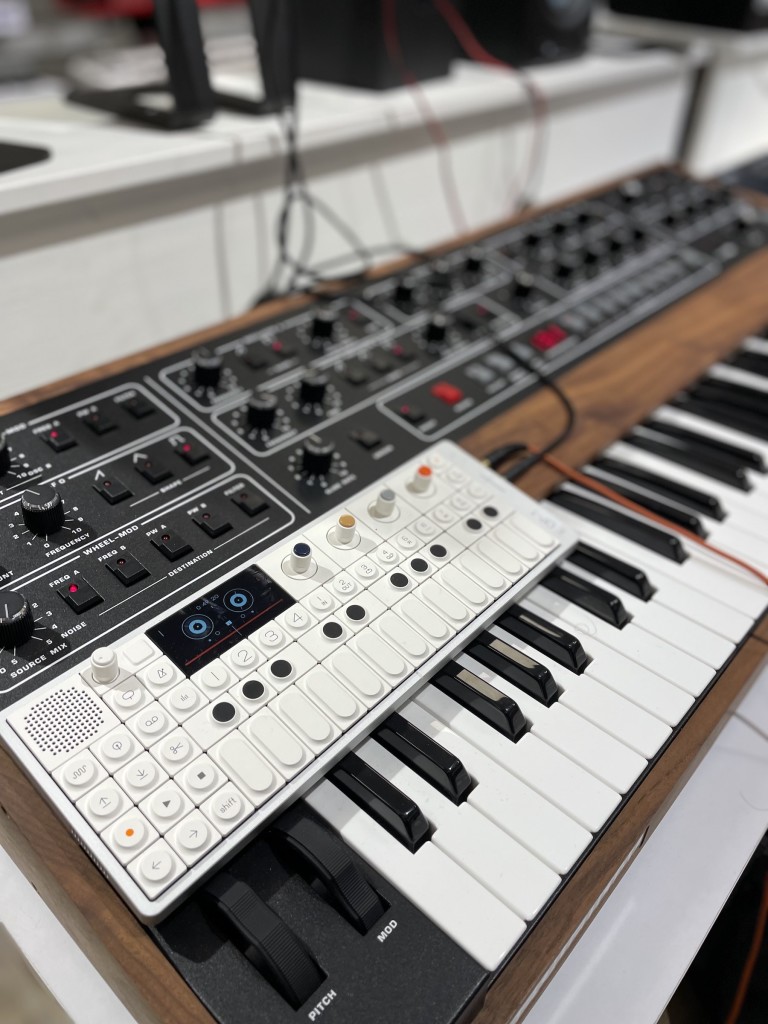
Studios
I had enough material to write some songs on just the OP-1. But my friends had some offerings to explore, too. Robert had an old Sequential Six-Trak he’d just refurbished. Daniel recently brought out his original Roland RE-201. Kristian suggested I come and play his Yamaha CVP Grand Piano. And Joel had a few live jams from his guitar going.
I couldn’t resist the offers, so I toured these regular studios and hooked up the Field to a bunch of vintage keyboards. I recorded stuff until I was told to leave. I even located an old Korg Delta string machine right next to that aforementioned Six-Trak. I sent out from the Field’s tape into the Roland Space Echo and back again. I let the Field cosy up to the Yamaha grand piano and played some Mozart. I’ll never play that back to you, because I’m not the pianist I used to be, but I did cut out a few parts and made those divine harmonies into short loops of sheer beauty. And I sat down in Joel’s favorite chair and did nothing but listen as he improvised a few sets with his acoustic guitar straight into the OP-1. There was no line input this time, either — just the musician, the room and the instrument.

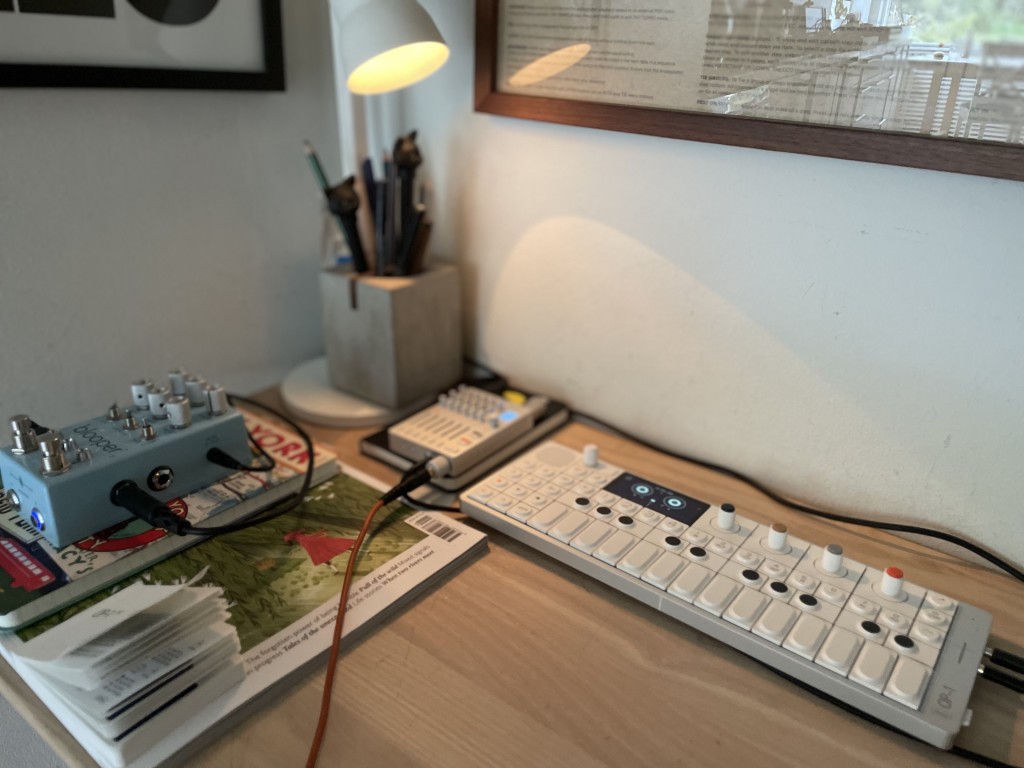
Structure
With all this material, it was time to write some songs. I had wrongfully assumed that a tape was the equivalent of a project with total recall, but it’s not. My bad, really. Most, if not all, of the OP-1 Field’s mixer settings are shared across all tapes, so you’re essentially skipping between different recording techniques but remain in the same master environment. Tape settings are also global, such as playback speed and mutes. Load any reel, and it’ll slide into wherever you are in your settings right now.
It’s a drawback, if you approach it with the kind of expectations that I had. Maybe it’s not a flaw, because it fits the Field’s design intention, but it remains one of the more frustrating examples of that ethos. Not all ideas from 2011 are worth preserving. I get that the current approach made more sense when there was only one tape with four tracks. Now, I have four tape sections with eight slots each. I can recall them whenever I want, but I can’t recall some of the individual settings that shape some of their sound.
But this is a creative framework built on conscious choices. The fact that Teenage Engineering added pre-pan recording but not individual mixer settings in their most recent update, goes some way to show how they feel about this themselves. What’s been left out matters as much as what got included. You need to be aware of your own pain points, to know if this or other parts of the Field will hurt you or not. Myself, I eventually embraced it. I sat down, wrote a few songs, rendered them directly from the OP-1 Field using its album feature, and tweaked the tape live as I did. I felt pretty good about the results. That has to count for something, right?
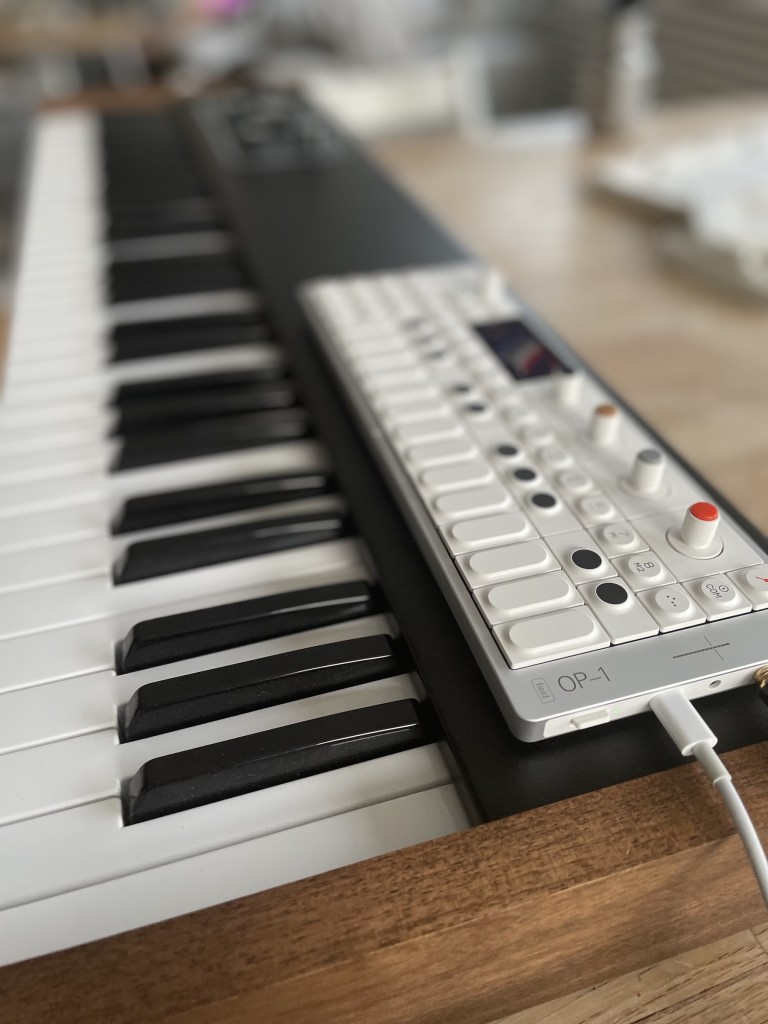
Where to next?
So where does all this lead the typical musician? Contrast the OP-1 Field to the do-everything-on-the-box Elektron approach. When you approach the Field as a free-form recorder with creative processing features, you reach the very essence of songwriting. It’s all about having a linear flow with ambient noodles, acoustic improvisations, free-form jams, layered textures, picking something up and dropping it somewhere else. Nothing can touch the Field here.
The conceptually strong focus on tape is both the Field’s strongest and weakest point. After more than ten years, the approach remains fresh and inspiring. I’m writing stuff on this that I wouldn’t come up with elsewhere. But some of the rest of the device pales beyond songwriting – just as Teenage Engineering aspires to do more. It’s not that the synths and samplers aren’t good. But every time you engage with the tape, you wonder what it would have been like if more of that innovation and detail had been applied to the OP-1’s other areas. Probably over time, we’ll just accept that there are better synths, sequencers, and drummers out there and return to those and record them right into the OP-1.
As much as all the Akais, Deluges, and Rolands do their best trying to make a song mode, they seem stuck in forcing a sequencer to be a songwriting experience. The Field acknowledges that the process of writing is different. It provides you with an open-ended space that inspires and nudges you forward, past points of no return that enable new ideas to emerge. As a once classically-trained pianist that over the years merged into electronic musician, this approach is totally who I am.
I don’t recall when I last felt that everything was so simple – how clear and obvious the idea of engaging in music was.
Conclusion
The old gen OP-1 arrived in 2011, when releasing any kind of hardware was enough to attract attention. Now, in 2022, the climate is different. For a musician who can afford the Field, it’s difficult not to flinch when you put the OP-1 next to the Deluge or the MPC Live. But I think there’s space for any instrument that’s designed to lead your talent onto new paths. (And forget just buy an iPad” – that’s out of touch with what creating music is all about.) For me, that’s finding the youth in me again, the boy who engaged in music for the sole reason that it made him whole, for the serenity it brought to sit down and play, for the raw electricity through your body when you’ve finished a song. I do have that with my current rig. I produce stuff; I release some. It’s not all bad.
With the OP-1 Field, I don’t recall when I last felt that everything was so simple – how clear and obvious the idea of engaging in music was. It helps me remember why I got into this in the first place. It arrives at a time when the noise has become so loud, I’m struggling to hear my own thoughts. The OP-1 Field cuts through all this and invites you to a place where there’s just you, your music and your ideas. It does so with confidence, clarity and purpose. Like any pristine voice, it might not be one that you enjoy. But hear it out before you dismiss it. Because until you have, you’ve heard nothing like it before. Especially not in 32 bits.

Music
Andreas has made “an entire album on the Field only, mixing and mastering done on the TX-6 with only some Chase Bliss gear for flavour (a lot of flavour, tho).”
More on firmware updates from November, January:
All photos courtesy the author.
